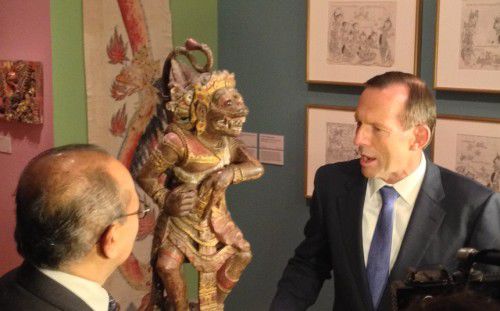DURING a rare visit to the National Gallery of Australia this morning, an enthusiastic Prime Minister Tony Abbott opened an exhibition of Balinese art that draws both in Australia’s neighbourly relationship with Indonesia and the gallery’s, exceptional collection of art from the archipelago.
“In some respects it is our most important relationship,” he said of Australia’s sometimes-fraught association with Indonesia.
“Art,” he said, “is the thoughtful reflection of our human experience.” In times of crisis, he said, the most irreplaceable object to most people was the family photo album and the NGA “is that to Australia.”
Mr Abbott pointed out that more than 800,000 Australians travelled to Bali each year, saying, “twice Bali has been a place of anguish,” but that there was joy within the relationship. “Indonesia is a Muslim country but it is a pluralist society” he said as he praised the NGA’s forefathers for having collected Indonesian art over a period of 50 years or so.
Indonesian ambassador Nadjib Riphat Kesoema praised the NGA’s initiative in setting up this exhibition, which he predicted would have many visitors “astonished and amused.”
The ambassador described Bali as “a showcase of warmness and opened heartedness” and said that during his recent six-month “holiday” [a reference to his enforced return to Jakarta after the presidential phone tapping crisis] he had visited Bali, no fewer than four times. He said he hoped the exhibition would prove an opportunity to develop knowledge of Indonesia and its “spirit of warmness and openness,” concluding “there is no other choice for Indonesia and Australia, but to become close friends.”
NGA director Ron Radford said that the NGA was particularly strong in Indonesian art, but that this was the first time it had focused on one particular island. Stage 2 plans for the gallery included a gallery dedicated specifically to Indonesian art, he said.
There is a feast of Indonesian culture at the National Gallery of Australia right now and members of the general public more familiar with Bali as a tourist destination do well to soak it up. The photographic exhibition of works from the 1850s to 1940s Gardens of the East” has been running for many months and now this exhibition of Balinese art is open, designed to “excite and surprise.”
![Scenes from the Mahabharata; valance for a temple or pavilion [ider-ider] (detail) late 19th century, silk, dyes, gold thread, tinsel, sequins, glass beads, cotton; appliqué, embroidery, couching, NGA, gift of Michael and Mary Abbott 1988](http://citynews.com.au/wp-content/uploads/2014/06/81257-500x494.jpg)
Scenes from the Mahabharata; valance for a temple or pavilion [ider-ider] (detail) late 19th century, silk, dyes, gold thread, tinsel, sequins, glass beads, cotton; appliqué, embroidery, couching, NGA, gift of Michael and Mary Abbott 1988
It is well known that the NGA holds the world’s most celebrated collection of Indonesian textiles, and Senior Curator, Asian Art, Robyn Maxwell has not stinted herself in drawing on the collection to create an exotic exhibition that conjures the magic of Bali before it became associated with sun, sex and sand.
Through the often highly pictorial sculpture, textiles, paintings, architectural elements and ritual objects, the gallery has evoked the cycle of Hindu festivals, communal celebrations and daily domestic worship on “Pulau Dewata” – the island of the gods.
Among the most admired textiles are the geringsing, unique to one village where, through double ikat, the most complex of techniques, both the warp and the weft threads are separately tied into the designs, which only become evident when interlaced during the weaving process. The most striking of the handspun cotton geringsing (a term loosely translated as ‘protection from illness’) display scenes of praise and adoration akin to the bas-relief stone sculptures on Hindu temples in Bali and on surviving remains from mediaeval Java.
Other Balinese textiles are vibrantly coloured, with heroic figures, floral fantasies and dynamic religious symbols, as well as painted hangings that often draw their imagery from Hindu symbols and legends, most notably the tensions and battles in the two great epics, “The Ramayana” and “The Mahabharata”.
The brilliantly painted sculptures in the exhibition are and range from Hindu images, such as the god Vishnu mounted on his vehicle the giant Garuda bird, to ferocious guardian creatures.
“Bali: Island of the Gods,” at the National Gallery of Australia, until August 3. The accompanying book now on sale at the Gallery includes essays by Robert Maxwell and her assistant curators, Niki van den Heuvel, Melanie Eastburn and Lucie Folan. RRP: $29.95
The post Tony Abbott opens a Feast of Balinese art at NGA appeared first on Canberra CityNews.
